Caipirinha is a delicious and easy to make Brazilian drink. It’s made with cachaça (Brazilian spirit), limes, sugar, and ice. It’s so refreshing and well-balanced. You can taste the sourness from the lime and the sweetness from the sugar. We absolutely love it! I have for you a step-by-step tutorial on how to make the traditional lime version, and also 4 fruit variations.
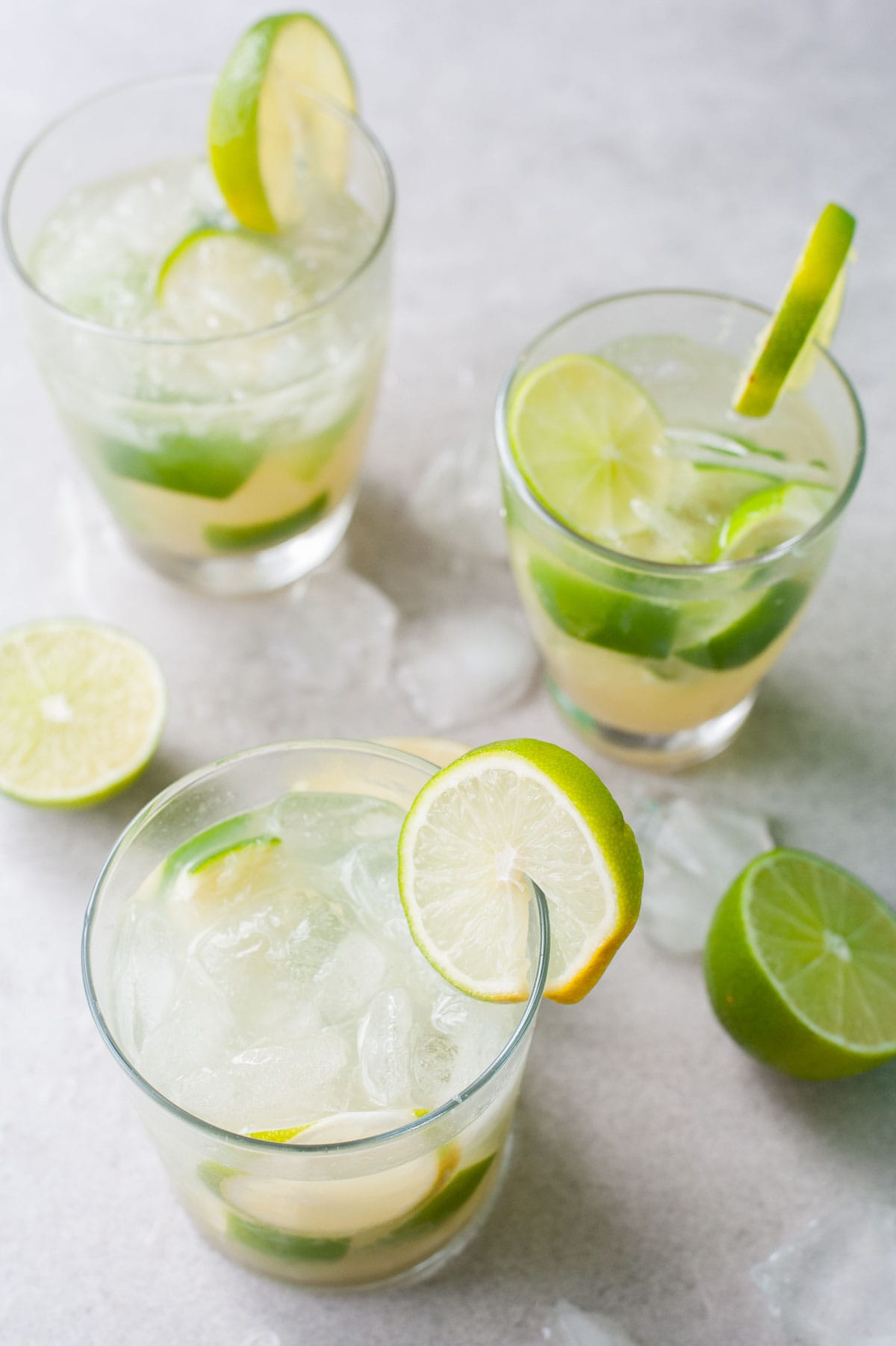
Ingredients + Ingredient substitutions
1. Cachaça – it’s the best-known Brazilian spirit. It’s similar in taste to rum. Both rum types are a byproduct of making sugar. The difference between cachaca and white rum is that the first one is made from fresh cane juice (first-pressed) and the second is made from molasses (this is thick, dark brown syrup obtained from raw sugar during the refining process).
A note about the alcohol content of this drink. This is a really lovely refreshing drink, but its alcohol content is high. This is a kind of drink that can sneak on you quickly! There isn’t much liquid – it’s mostly rum, a little bit of lime juice, and some water that comes from the ice. It’s so good that you can’t really taste that you’re drinking so much alcohol!
What is the alcohol content of cachaça? It has an alcohol content of 38-54% by volume, so it’s similar to vodka.
It may be a little confusing how to pronounce these words if you’re hearing them for the first time. Here’s how to pronounce it:
– How to pronounce caipirinha: it’s Kai-Pee-Reen-Ya.
– How to pronounce cachaça: it’s Ka-Shah-Suh.
How to substitute: There’s really no good substitute for cachaca since it’s the main ingredient of the drink! But, if you don’t have it on hand you can try to substitute it with white rum. The drink will taste a little different of course, but if you are serving it to someone who hasn’t drunk true caipirinha before, the chances are they won’t notice the difference. Bear also in mind, that the caipirinha with rum is essentially daiquiri with ice..
I’ve tried side-by-side one drink made with cachaca and the second made with white rum and could taste the difference – it tasted better with cachaca for me, but the difference wasn’t that huge. I also served both these drinks to another person and he couldn’t guess which drink was made with cachaca and said that both tasted great.
2. Limes – lime juice is squeezed out of fruit and makes this drink so refreshing. Lime zest adds an additional aroma to the drink.
I wouldn’t substitute limes for anything else. Some recipes call for lemons instead of lime but for me, it is the lime juice that makes this drink so refreshing and lemon just doesn’t work well here. The sourness of the lime makes the high alcohol content barely noticeable.
If you can, select ripe limes, which feel soft when you squeeze them.
3. Sugar – traditionally white (granulated) sugar or cane sugar are used and this is what I prefer, especially cane sugar.
Some recipes call for light brown sugar. I made the drink with it and didn’t like it so much – the color was darker (not appetizing) and the more intense, caramel flavor just didn’t go so well with clean and sharp flavors of lime and cachaca. I prefer cane or white sugar because of their neutral taste. I also prefer cane sugar over white sugar, it’s more flavorsome than totally bland beet sugar.
I also recommend superfine / caster / baker’s sugar. This is the same type of sugar as granulated white sugar but its crystals are finer. It’s something between granulated sugar and powdered sugar. If you’re using granulated sugar it won’t dissolve completely just after muddling it with lime pieces, so if you taste the drink it will be a little more sour at the top and a little sweeter at the bottom. Some people prefer this contrast, and some don’t and also dislike the sugar crunch.
The advantage of superfine sugar is that it will dissolve more quickly making the drink more uniformly sweet. The advantage of granulated sugar (its granules are bigger) is that it works like a ‘peeling’ – it helps to extract the aromatic oils from the lime’s skin, making the drink more aromatic.
This recipe was developed using cane sugar so if you’ll use superfine sugar you will need to add just a little less than in the recipe. I like to use regular granulated cane sugar (bigger crystals) which just suits more the rustic nature of this drink.
4. Ice: I prefer to use whole (but small) ice cubes to chill the drink – it’s easier to drink, more authentic and it looks nicer. If you have big ice cubes, make sure to break them into smaller pieces.
You can also use crushed ice – the advantage is that the crushed ice will dissolve quicker letting you enjoy the drink a little longer. Cachaca on its own can have a little harsh, grassy, alcohol taste, so diluting its flavor with ice (water) can make it for some easier to drink. The alternative would be to use whole ice cubes and add some water or soda to the drink to have more liquid.
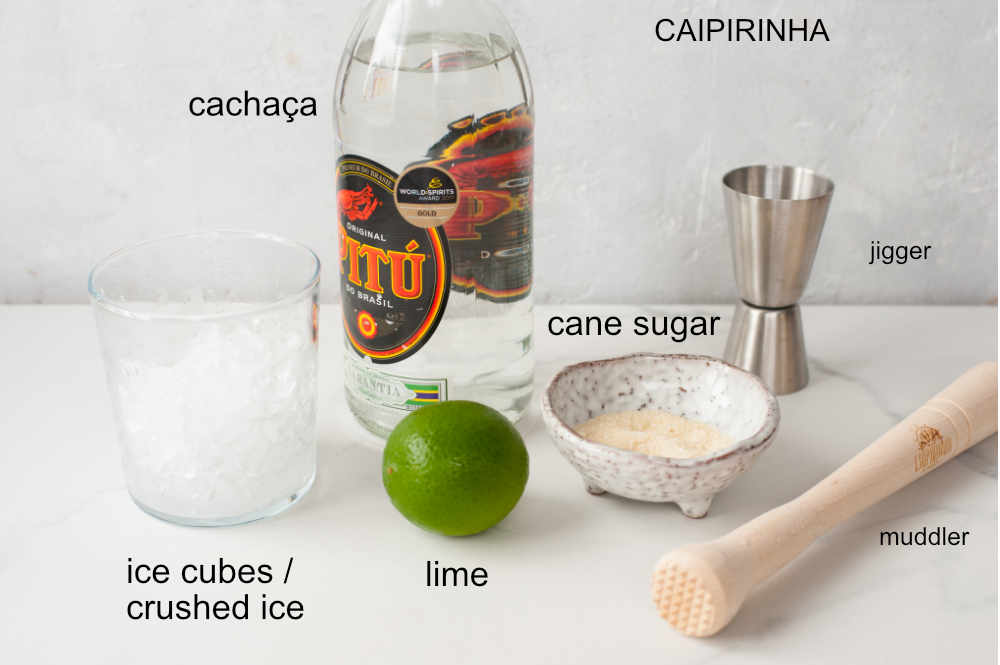
Equipment
There is no special equipment that you need to make this drink, but a drink muddler and a jagger may come in handy.
A muddler is a bartender’s tool, used to pestle / mash / to muddle fruits and herbs in the bottom of the glass to release their flavor. In this recipe, it’s used to squeeze the juice out of the lime and to release fragrant oils from the lime zest. You can buy metal or wooden muddlers. I have bought a wooden one (it’s shown above on the photo) and it works fine, but it gets discolored if you use it with fruits like strawberries. You can use this muddler to make other drinks, like a mojito. Instead of a muddler, you can use a wooden pestle or wooden spoon.
A Jigger is an hourglass-shaped measuring cup used to measure alcohol or juice when making drinks (it’s shown above on the photo). If you like making drinks at home you’ll find it very useful! You can also look for other shot glasses or cups in your home, which have a similar capacity. For example, I’ve found that my soft egg holder holds exactly 30 ml which is 1 fl oz.
What kind of glass to use
Caipirinha is most often served in an old-fashioned glass, like for serving whiskey (a short glass). Make sure to use a sturdy glass to not break it with the muddler (it’s unfortunately not that difficult to do!).
Proportions of the ingredients
The IBA (International Bartender Association) provides the following ingredients: 50ml/1.7oz Cachaça, 1/2 Fresh lime, 2 teaspoons sugar, and ice.
I’m using just a little more alcohol (2oz/60ml) to use up the full 2 fluid ounces (US). If you’re in Europe or AU your jigger will probably fit 50 ml, you can also use just this amount.
I’m also doubling the lime and sugar (I’m using 1 whole lime and 1.5 Tbsp of sugar) to make the drink taste more bold! The most important is the balance between sweet sugar, sour lime, and harsh alcohol, so if you choose to change the proportions, bear that in mind!
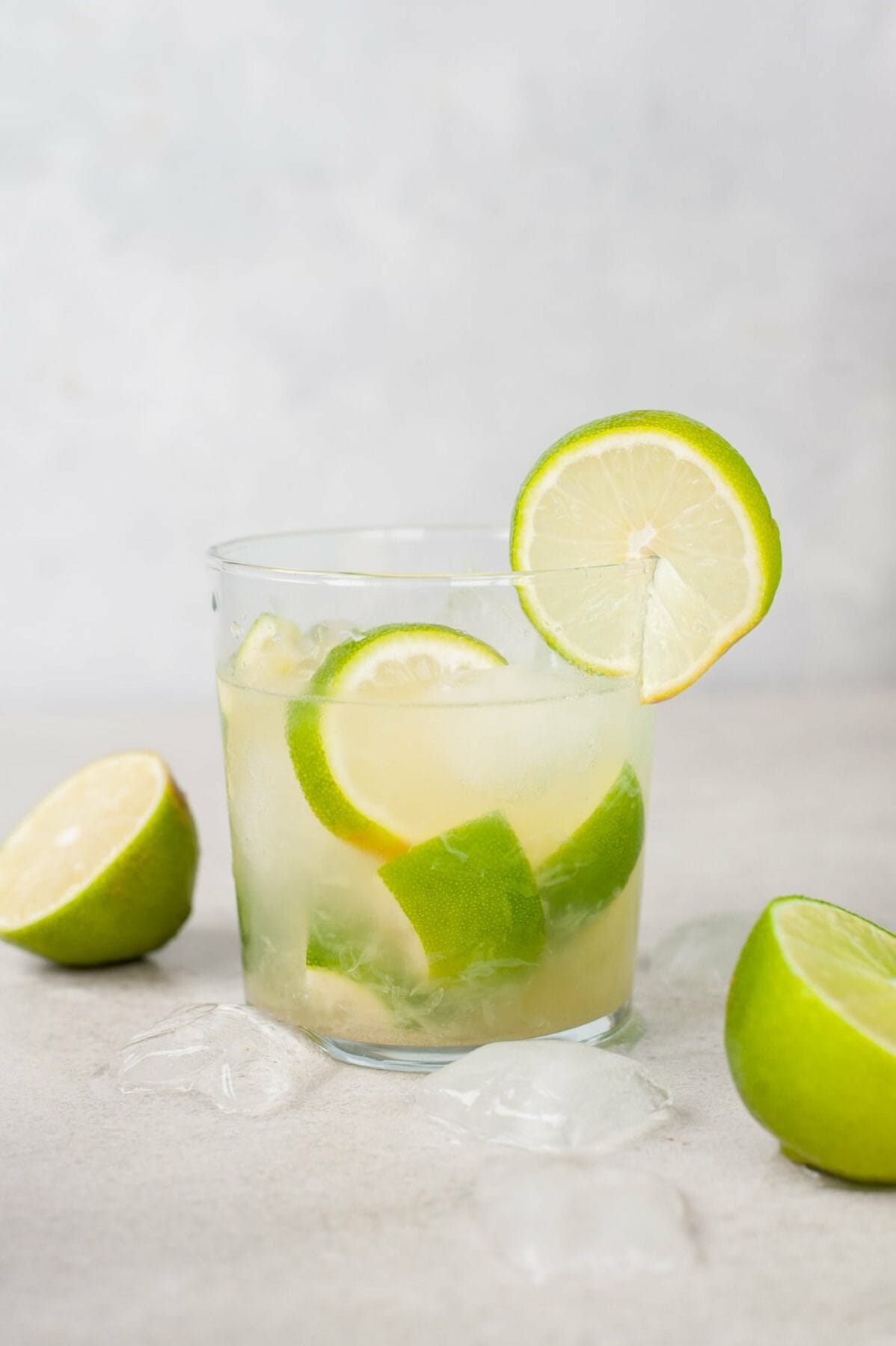
Preparation methods
traditional preparation method:
In a nutshell, to make a classic caipirinha you need to cut 1 lime into 8 parts, muddle (mash) it with 1.5 Tbsp of cane sugar, then add 2 fl oz (60ml) of cachaca, stir, and fill the glass with ice. That’s it! It’s the most traditional and simple preparation method, and also my favorite. For me, it produces the best drink.
alternatively, you can make a shaken caipirinha:
To make a shaken drink, add all the ingredients into a shaker (or a big jar) and shake intensely. Drain the liquid and add to a glass filled with ice or just transfer the content of the shaker to glass. This method also makes a great caipirinha, but I think this is an extra step and is not necessary (it feels more like cachaca-based daiquiri). This is just a simple, rustic drink that should be made directly in the glass. The advantage of a shaken drink is that the sugar and all the flavors are distributed more evenly.
How to make a classic caipirinha step-by-step
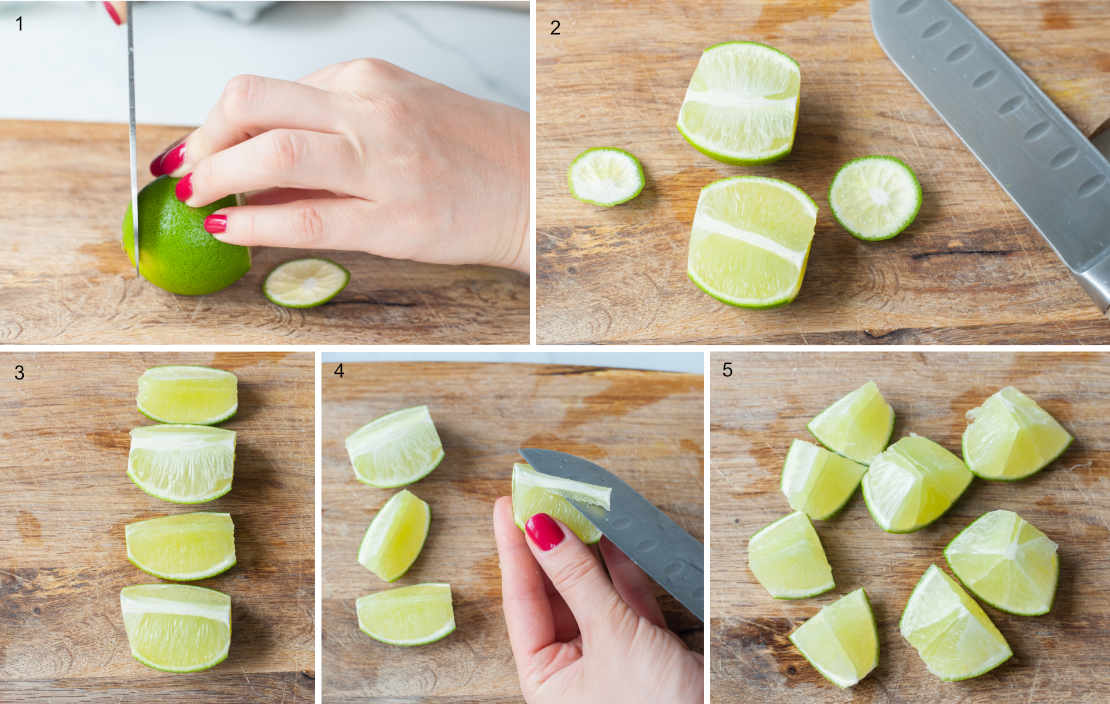
STEP 1: Cut 1 lime into 8 parts: first cut off the bottom and the top of the lime (only the zest and the white pith), cut the lime in half lengthwise (from pole to pole), then cut each part in half lengthwise, cut off the white pith from the center of the lime, then cut each lime quarter in half crosswise – you should have 8 parts (see the photos above).
These steps may seem unnecessary, but I’m telling you it does matter how you cut the lime. Lime cut this way is easiest to juice. I’ve also made two drinks, with the only difference between them being the removal of the white pith (at the top and the bottom of the lime, and also from the middle) and I could tell the difference. The drink with the white pith left on the limes was more bitter.
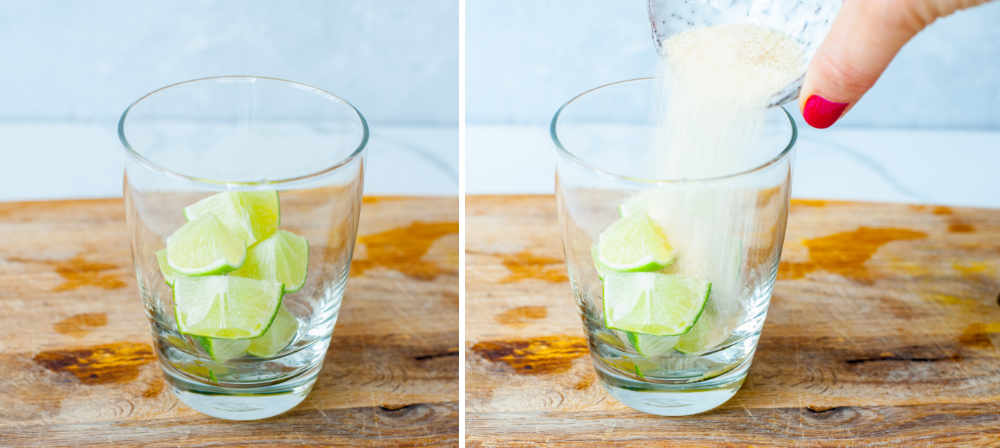
STEP 2: Place the lime pieces in a glass and add 1.5 Tbsp of cane sugar.
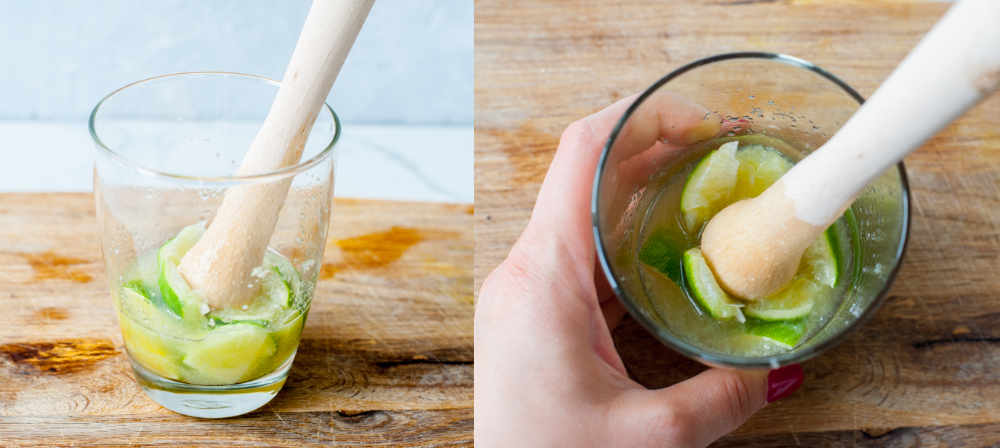
STEP 3: Press the ingredients with a muddler (or alternatively with a wooden spoon) trying to squeeze out as much lime juice as possible. Make sure to use a sturdy glass to not break it with the muddler (it’s unfortunately not that difficult to do!).
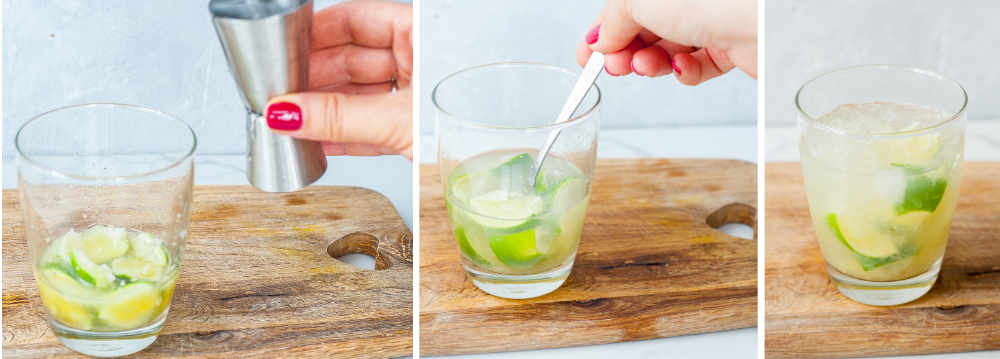
STEP 3: Measure out 2 fl oz (60 ml) of cachaça and add to the glass. Stir thoroughly with a teaspoon.
STEP 4: Fill the glass with ice cubes or crushed ice and stir once again thoroughly.
Garnish with lime slices. You can also serve the drink with a straw. Serve immediately.
Remember to adjust the taste to your liking! Limes vary in sourness. If your drink is too sour add powdered sugar or if it’s too sweet, add more lime juice. A perfect caipirinha is all about achieving a perfect balance between citrus tartness, sugar sweetness, and the sharpness of the alcohol.
Saúde! (Cheers!)
Other variations of the drink
- made with sake instead of cachaca – it’s called sakedina or caipisake
- made with vodka – it’s called caipiroska
- prepared with rum instead of cachaça – it’s called caipiríssima
- Caipirinha with fruit is called caipifruta and it’s really amazing. The most traditional caipirinha recipe calls only for limes, but there are other citrus and fruit you could add to make an amazing drink. I tested this recipe with strawberries, mango, pineapple, and kiwi. I’m always adding some lime anyway because I love its flavor here and like I said before it is what primarily makes this drink so refreshing. My favorite is with strawberries and mango.
See our collection of fruity drink recipes!
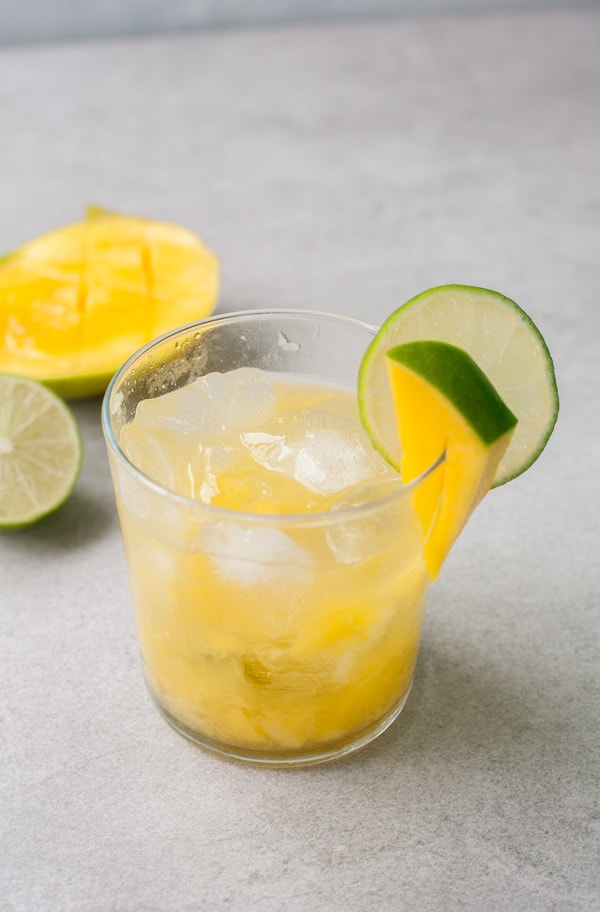
mango caipirinha:
Cut 1/2 lime into quarters, add into a glass with 8 (1/2-inch / 1cm) chunks mango and 1/2 Tbsp sugar (or 1 Tbsp if the mango is not very ripe). Muddle (mash) the ingredients, then add 2 oz (60 ml) cachaça and stir. Fill the glass with ice cubes.
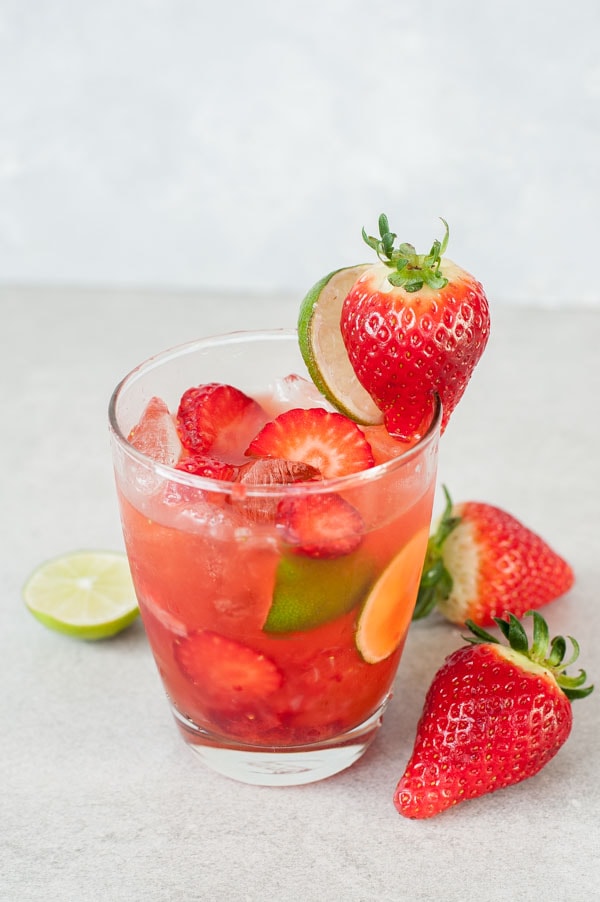
strawberry caipirinha:
Cut 1/2 lime into quarters, add into a glass with 2 large strawberries and 1 Tbsp sugar (or 1/2 Tbsp if the strawberries are very sweet). Muddle (mash) the ingredients, then add 2 oz (60 ml) cachaça and stir. Fill the glass with ice cubes. Garnish with additional strawberry slices. (We also have a similar cocktail with rum – strawberry basil cocktail).
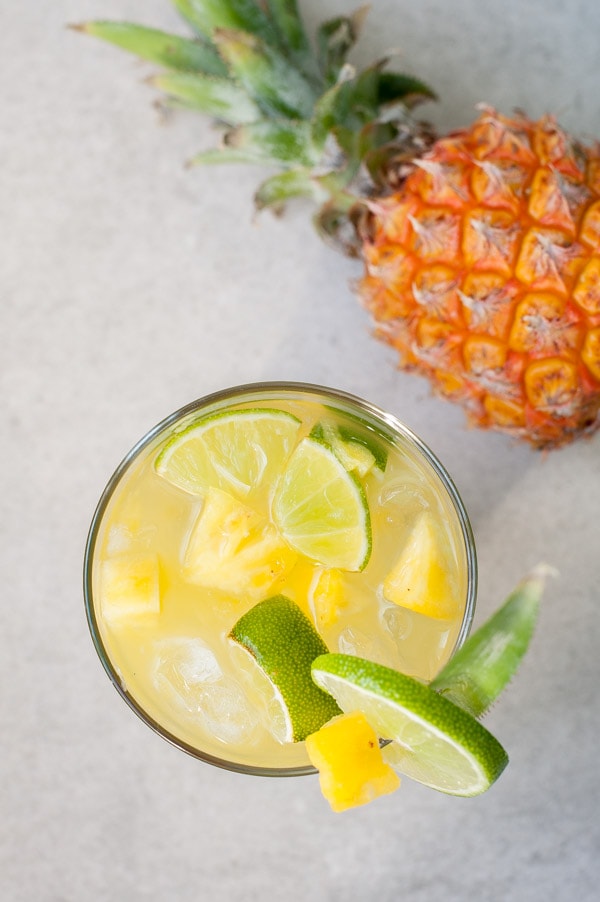
pineapple caipirinha:
Cut 1/2 lime into quarters, add to a glass with 10 (1/2-inch / 1cm) chunks fresh pineapple and 1 Tbsp sugar. Then add 2 oz (60 ml) cachaça and stir. Fill the glass with ice cubes.
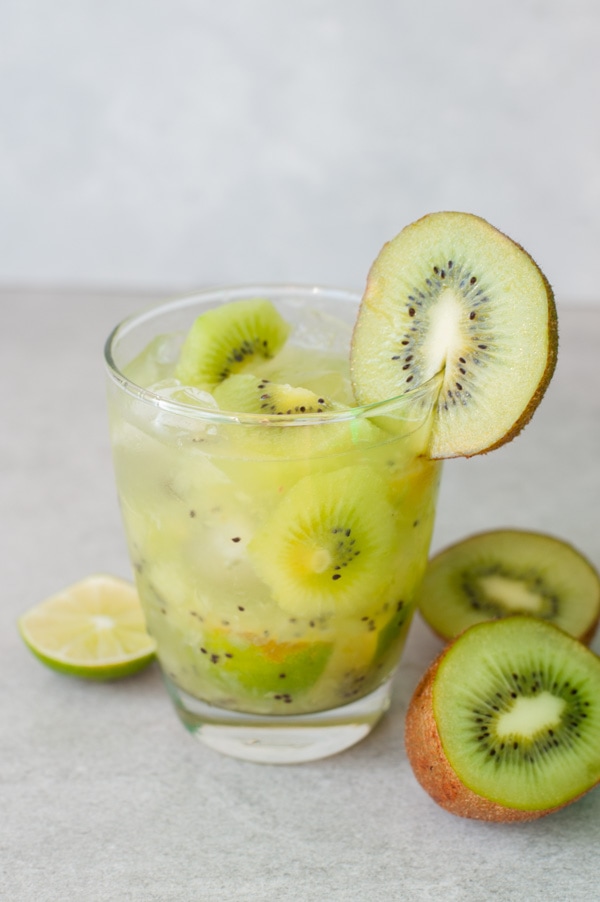
kiwi caipirinha:
Cut 1/2 lime into quarters, add to a glass with 1/2 large kiwi and 1 Tbsp sugar (or more if the kiwi is not ripe and sweet). Add 2 oz (60 ml) cachaça and stir. Fill the glass with ice cubes.
Virgin caipirinha
Try to use sparkling water instead of cachaca.
FAQ
Caipirinha is made with cachaça, whole limes, and granulated sugar, and a mojito is made with rum, lime juice, mint, and sugar syrup. Caipirinha is usually served in a short glass and a mojito in a tall glass. Both drinks are clear, a little sweet, refreshing, served with lots of ice, and are muddled, but they taste very different.
Yes, you can. The drink will taste slightly different though. For the best flavor, use a cachaça.
If you’re looking for other refreshing drinks, check out my pina colada recipe or grapefruit mimosa recipe!
Did you make this recipe? RATE THE RECIPE or tell me in the COMMENTS how you liked it! You can also add a photo of your dish. It would make me very happy and will help other readers. Thank you!!
Caipirinha Recipe (+ 4 fruit variations!)
Ingredients
traditional caipirinha:
- 1 lime
- 1.5 tablespoons cane sugar or granulated sugar superfine sugar can also be used
- 2 oz 60 ml cachaça Brazilian liquor
- 1 cup ice cubes or enough to fill a small glass
mango caipirinha:
- 1/2 lime
- 8 1/2-inch / 1cm chunks mango
- 1/2 Tbsp sugar or 1 Tbsp if the mango is not very ripe
- 2 oz 60 ml cachaça
- 1 cup ice cubes or enough to fill a small glass
strawberry caipirinha:
- 1/2 lime
- 2 large strawberries
- 1 Tbsp sugar or 1/2 Tbsp if the strawberries are very sweet
- 2 oz 60 ml cachaça
- 1 cup ice cubes or enough to fill a small glass
kiwi caipirinha:
- 1/2 lime
- 1/2 large kiwi
- 1 Tbsp sugar or more if the kiwi is not ripe and sweet
- 2 oz 60 ml cachaça
- 1 cup ice cubes or enough to fill a small glass
pineapple caipirinha:
- 1/2 lime
- 10 1/2-inch / 1cm chunks fresh pineapple
- 1 Tbsp sugar
- 2 oz 60 ml cachaça
- 1 cup ice cubes or enough to fill a small glass
Would you like to save this?
Instructions
- Cut the lime into 8 parts: first cut off the bottom and the top of the lime (only the zest and the white pith), cut the lime in half lenghtwise (from pole to pole), then cut each part in half lenghtwise, cut off the white pith from the center of the lime, then cut each lime quarter in half crosswise – you should have 8 parts (see the photos in the body of the post).
- Place the lime pieces in a small glass, add the sugar and fruits (only if you’re making fruit caipirinha). Press the ingredients with a muddler (or alternatively with a wooden spoon) trying to squeze out as much lime juice as possible.
- Measure out cachaça and add to the glass. Stir thoroughly with a teaspoon.
- Fill the glass with ice cubes or crushed ice and stir once again thoroughly.
- Garnish with lime slices (and also fruit pieces if you’re making fruit caipirinha). You can also serve the drink with straws. Serve immediately.
- Saude! (Cheers!)
Notes
- Caipirinha is a rather strong drink. If you find it too strong to your taste, dilute it with water/sparkling water/soda water/club soda.
- Remember to adjust the taste to your liking! Limes vary in sourness. If your drink is too sour add more sugar (or powdered sugar) or if it’s too sweet add more lime juice. A perfect caipirinha is all about achieving the perfect balance between citrus tartness, sugar sweetness, and the sharpness of the alcohol !
- Sugar: my favorite is cane sugar but you can also use white (granulated sugar). A good alternative is also superfine / caster / baker’s sugar – this is the same sugar but its crystals are smaller – it will dissolve more quickly in the drink.
- Ice: you can use ice cubes or crushed ice. I prefer ice cubes (rather small). If you have very large ice cubes, break them up into smaller pieces.
- What kind of glass to use: Caipirinha is most often served in an old-fashioned glass, like for serving whiskey (a short glass). Make sure to use a sturdy glass to not break it with the muddler.
- I’m using 2 fl oz (60 ml) of cachaca in this drink, but if you’re in Europe or AU your jigger will probably fit 50 ml, you can also use just this amount.
- You can also make a shaken caipirinha – this way the ingredients are more uniformly mixed but this is an extra step and extra glass to wash. To make a shaken drink, add all the ingredients into a shaker (or a big jar) and shake intensely. Drain the liquid and add to a glass filled with ice or just transfer the content of the shaker to glass.
- Virgin caipirinha: try to use sparkling water instead of cachaca.
- Calories count = 1 drink (trditional lime caipirinha). This is only an estimate!

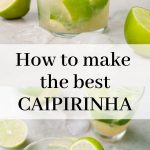
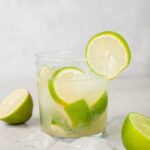
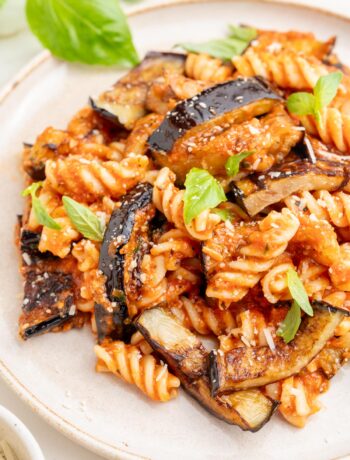
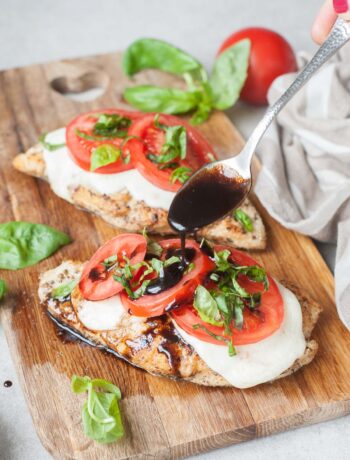
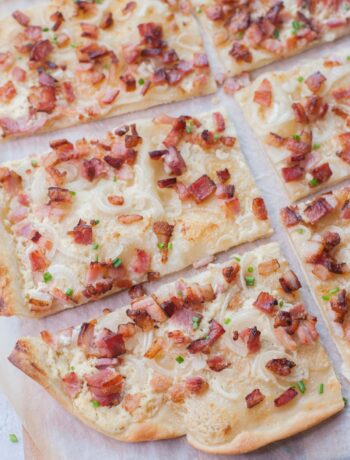
2 Comments
Shannon
4 October 2022 at 21:53I love this drink!! I’m surprised though that people compare cachaça to rum. To me, it tastes much closer to tequila, and a caipirinha tastes very close to the best margarita I’ve ever had. I’ll be trying these fruity variations soon.
Aleksandra
5 October 2022 at 13:40I’m glad you liked the recipe. Let me know which fruity variation you liked best. Thank you for leaving the comment!